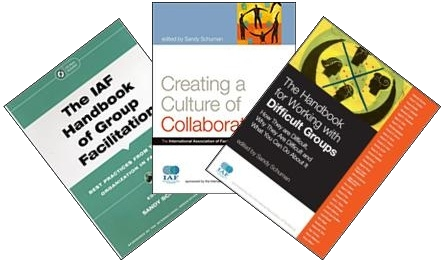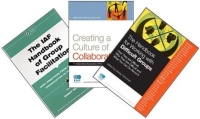|
The IAF Handbook of Group Facilitation: Best Practices from the Leading Organization in FacilitationSandor Schuman, Editor |
“All of the chapters were good -- some of them were outstanding. ... Facilitators of all experience levels should find this handbook helpful … I found the handbook to be comprehensive, well written, and full of useful ideas.”More…
~ M. Peter Scontrino, Personnel Psychology (Vol. 59, No. 1, (2006), pp. 271-274).
An extraordinarily rich and in-depth introduction to the subject … we find this book to be a terrific resource for practitioners.” More…
~ Yvette Borcia and Gerry Stern, Stern's Management Review Online
“From the day it arrived I began using it. … a must have for those concerned with
the profession of facilitation.” More…
~ J. C. Jenkins
“I purchased 3 different books regarding faciliation techniques and guidelines and this was the ultimate. …” More…
~ Melissa Smith
Book Review by M. Peter Scontrino
Personnel Psychology (Vol. 59, No. 1, (2006), pp. 271-274).
Merriam-Webster’s New Collegiate Dictionary defines a handbook as, “A concise reference book covering a particular subject; a book capable of being conveniently carried as a ready reference.” The IAF Handbook of Group Facilitation is an excellent example of this definition, although one might argue that a 664-page hardcover book is difficult to carry conveniently.
IAF is the International Association of Facilitators. According to the their Web site (http://iaf-world.org/), the IAF “was formed by a group of professionals desiring an avenue for interchange, professional development, trend analysis, and peer networking. A formal association was proposed and adopted at a networking conference in Alexandria, Virginia, in January 1994. More than 70 people signed on as charter members. Since then, the IAF has grown to over 1,300 members in more than 20 countries.
The International Association of Facilitators is the recognized source for credible and valuable professional help for practicing facilitators. IAF members work and consult with corporations, government agencies, nonprofit organizations, schools, educational institutions and communities in over 30 countries. They contribute to organizational and social change using applied group process methodologies.”
Your reviewer has been active in the facilitation field long before the inception of the IAF 11 years ago.Yet, I had not come across any references to the IAF in my work or in the conferences that I have attended. I did go to the IAF Web site and found that their work includes facilitator competencies, conferences, workshops, and facilitator credentialing. Both the competencies and the credentialing process are discussed in detail in two of the chapters of the handbook.
Fifty authors contributed to the chapters in this handbook. Short biographies are presented for each of the authors. Forty-one of the authors are fulltime consultants, and nine of them are affiliated with universities. This group of authors brings hundreds of years of hands-on experience to this handbook. This experience is quite evident in the richness of the examples and practical tips provided.
Between 1995 and 2000, the IAF developed a competency model for facilitators. This competency modeling process is described in Chapter 26 of the Handbook. The competency model includes six major categories with two to four subcategories for each major category. In addition, each subcategory includes three to five behavioral descriptions that define the subcategory.
The IAF Handbook is structured around this competency model. The major categories and subcategories of the competency model are presented below:
A. Create collaborative Client Relationships
1. Develop working partnerships
2. Design and customize applicants to meet client needs
3. Manage multi-session events effectively
B. Plan Appropriate Group Processes
1. Select clear methods and processes
2. Prepare time and space to support group process
C. Create and Sustain a Participatory Environment
1. Demonstrate effective participatory and interpersonal communication skills
2. Honor and recognize diversity, ensuring inclusiveness
3. Manage group conflict
4. Evoke group creativity
D. Guide Group to Appropriate and Useful Outcomes
1. Guild the group with clear methods and processes
2. Facilitate group self-awareness about its task
3. Guide the group to consensus and desired outcomes
E. Build and Maintain Professional Knowledge
1. Maintain a base of knowledge
2. Know a range of facilitation methods
3. Maintain professional standing
F. Model Positive Professional Attitude
1. Practice self-assessment and self-awareness
2. Act with integrity
3. Trust group potential, and model neutrality
The introduction to the handbook includes a matrix that presents the categories of the competency model in the first column and the chapter numbers across the first row of the table. The matrix identifies which chapters provide information related to each of the competency categories and subcategories. I found this matrix to be quite helpful.
Most of the 33 chapters are 15 to 20 pages in length. In general the author(s) of each chapter outlined the content of their chapter, provided examples and mini case studies, and offered many practical suggestions. An example of a practical suggestion is the set of interview questions included in the first chapter. These questions are designed to help a client elaborate on their problem or need:
- What are the key issues and problems with which your company is dealing?
- How do these affect your department?
- Who are the stakeholders outside your department who are affected?
- Howwill the resolution of these issues affect other teams, department, and divisions in our company?
- What are your competitors doing regarding these issues?
- What is a trend in your industry that you believe will affect your company? When did it emerge?
- What areas need improvement to stay abreast of the developments in your industry?
Your reviewer has used similar questions and knows that these questions are effective in helping a client define a problem. All of the chapters were good—some of them were outstanding. I particularly liked the chapters on facilitator competencies, facilitating the start of effective teams, creating an ongoing client relationship, the “eight P’s” of effective facilitation planning, consensus building, and facilitating large group meetings that get results. I liked these particular chapters because they included information that I can use immediately on current projects.
A CD ROMis included, but there is nothing in the handbook itself that discusses the content of the CD in any detail. The CD includes a number of articles, links to over 80 websites, and selected exhibits from the text.
Facilitators of all experience levels should find this handbook helpful. Relatively inexperienced facilitators will find many tools that can be used to begin to fill their toolbox. Experienced facilitators will find processes and techniques that can be used to refine the work they are doing.
I found the handbook to be comprehensive, well written, and full of useful ideas. I plan to recommend it to my facilitator colleagues.


